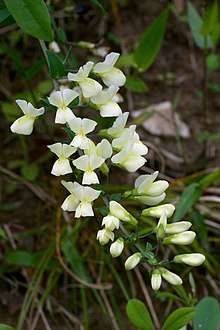Baptisia bracteata
Baptisia bracteata, otherwise known as longbract wild indigo,[1] long-bract wild indigo, long-bracted wild indigo, or cream false indigo, is a perennial herbaceous plant that is native to the central and eastern United States.[1] It is one of the earliest blooming species of Baptisia, beginning to bloom in March in certain areas of the United States.[2] The bloom color ranges from white to creamy yellow.[3] The flower clusters (racemes) spread out sideways or sprawl across the ground, unlike most other Baptisia species, which have vertical racemes. The flowers are visited by bumblebees.[3] The caterpillars of several skippers eat the leaves, including the wild indigo duskywing and hoary edge. The plant is poisonous to mammalian herbivores.[4]
| Baptisia bracteata | |
|---|---|
 | |
| Scientific classification | |
| Kingdom: | |
| (unranked): | |
| (unranked): | |
| (unranked): | |
| Order: | |
| Family: | |
| Subfamily: | |
| Genus: | |
| Species: | B. bracteata |
| Binomial name | |
| Baptisia bracteata Elliot | |
References
- "Baptisia bracteata". USDA Plants. Retrieved 23 November 2016.
- "Baptisia (False or Wild Indigo)". Clemson University, Cooperative Extension. Retrieved 2016-11-23.
- "Baptisia bracteata". Ladybird Johnson Wildflower Center. Retrieved 2016-11-23.
- Hilty, John (2016). "Cream Wild Indigo (Baptisia bracteata)". Illinois Wildflowers.
External links